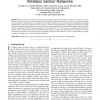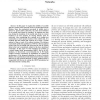120
Voted
TWC
2010
14 years 7 months ago
2010
In this paper, we study the problem of supporting multicast traffic in wireless sensor networks with network coding. On one hand, coding operations can reduce power consumption and...
128
click to vote
TON
2010
14 years 7 months ago
2010
Abstract--Energy efficiency is critical for wireless sensor networks. The data-gathering process must be carefully designed to conserve energy and extend network lifetime. For appl...
130
Voted
IJACTAICIT
2010
14 years 7 months ago
2010
Clustering in wireless sensor networks is one of the crucial methods for increasing of network lifetime. There are many algorithms in for clustering. LEACH algorithm is one of the...
137
click to vote
TMC
2011
14 years 7 months ago
2011
—Mission-driven sensor networks usually have special lifetime requirements. However, the density of the sensors may not be large enough to satisfy the coverage requirement while ...
126
Voted
ICC
2009
IEEE
14 years 10 months ago
2009
IEEE
Abstract-- Wireless sensor networks (WSNs) require energyef cient protocols to improve the network lifetime. In this work, we adopt a cross-layer strategy that considers routing an...
128
Voted
ESIAT
2009
IEEE
14 years 10 months ago
2009
IEEE
The applications of Wireless Sensor Networks are seriously constrained by energy supply. So how to prolong the network lifetime is an important and challenging issue, which is the ...
120
Voted
GLOBECOM
2010
IEEE
14 years 10 months ago
2010
IEEE
In this paper we explore the mobility of a mobile sink in a wireless sensor network (WSN) to prolong the network lifetime. Since the mechanical movement of mobile sink is driven by...
120
Voted
WIOPT
2010
IEEE
14 years 11 months ago
2010
IEEE
—The nodes in wireless sensor networks often collect correlated measurements. Not taking into account this information redundancy is detrimental to the network lifetime, since co...
114
click to vote
TMC
2010
14 years 11 months ago
2010
—To make a network last beyond the lifetime of an individual sensor, redundant sensors must be deployed. What sleep-wakeup schedule can then be used for individual sensors so tha...
127
Voted
INFOCOM
2010
IEEE
14 years 11 months ago
2010
IEEE
—Wireless sensor network (WSN) applications require redundant sensors to guarantee fault tolerance. However, the same degree of redundancy is not necessary for multi-hop communic...




